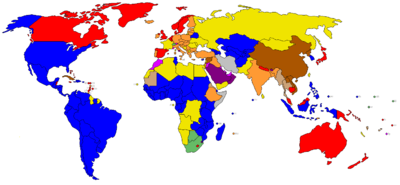List of countries by system of government
2007 Schools Wikipedia Selection. Related subjects: Politics and government

This is a list of countries categorized by system of government.
Presidential / Separated republics
Where a president is the active head of the executive branch of government and is independent from the legislature. The following list includes democratic and non-democratic states:
Full presidential systems
In full presidential systems, the president is both head of state and head of government. There is no prime minister.
Semi-presidential systems
In semi-presidential systems, there is a president and a prime minister. In such systems, the President has genuine executive authority, unlike in a parliamentary republic, but some of the role of a head of government is exercised by the prime minister.
|
Parliamentary republics
Where a prime minister is the active head of the executive branch of government and also leader of the legislature. However, there is also a president who serves as a symbolic head of state in some figurehead capacity. The following list includes democratic and non-democratic states:
Absolute monarchies
Monarchies in which the monarch is the active head of the executive branch and exercises all powers.
|
Constitutional monarchies
Where a prime minister is the active head of the executive branch of government and also leader of the legislature. The head of state is a constitutional monarch who only exercises his or her powers with the consent of the government and is largely a figurehead.
Semi-constitutional monarchies
The prime minister (or equivalent) is the nation's active executive, but the monarch still has considerable political powers that can be used at his/her own independent discretion.
Commonwealth realms
Constitutional monarchies, in which Queen Elizabeth II serves as head of state over an independent government. In each Realm, she acts as the monarch of that state, and is usually titled accordingly - for example, Queen of Australia. The Queen appoints a Governor-General to each country other than the United Kingdom to act as her representative. The prime minister is the active head of the executive branch of government and also leader of the legislature.
Theocracies
Non-democratic states based on a state religion where the head of state is selected by some form of religious hierarchy.
- Iran
- the Holy See (Vatican City)
One-party states
Non-democratic states in which political power is concentrated within a single political party whose operations are largely fused with the government hierarchy.
|
Military junta states
The nation's armed forces control the organs of government and all high-ranking political executives are also members of the military hierarchy.
Transitional
States which have a system of government which is in transition or turmoil and cannot be accurately classified.
Systems of Internal Governance
Federal
States in which the federal government shares power with semi-independent regional governments. In many cases, the central government is (in theory) a creation of the regional governments; a prime example is the United States.
|
|
Devolved
States in which the central government has delegated some of its powers to self-governing subsidiary governments, creating a de facto federation.
- Spain (17 autonomous communities)
- United Kingdom (Scotland, Northern Ireland, and Wales; England remains under full control of the central government)
Regionalized unitary
States in which the central government has delegated some of its powers to regional governments.
- Chile (13 regions, each one divided into smaller provinces, which are sub-divided into several municipalities).
- Italy (20 regions, five granted 'autonomous' status)
- New Zealand (12 regions, 4 unitary authorities)
- People's Republic of China (22 provinces, 5 autonomous regions, 4 municipalities, and 2 Special Administrative Regions: Hong Kong and Macau)
- Philippines (79 provinces grouped into 17 regions, one granted 'administrative' status and one granted 'autonomous' status)
- Serbia, significant autonomy granted to Kosovo.
Federacy
A federacy is a country in which some substates function like states in a federation and others like states in a unitary state.
- Denmark with 2 autonomous regions and 13 counties;
- Finland with 1 autonomous province and 19 regions;
- The Netherlands with 2 states and 12 provinces.
- France with 1 sui generis collectivity and 26 régions, 4 collectivités d'outre-mer, 1 territoire d'outre-mer
Unitary
see Unitary state